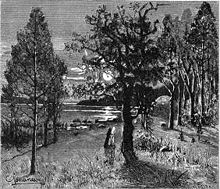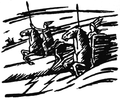
Bragi is the skaldic god of poetry in Norse mythology.

The Norns are deities in Norse mythology responsible for shaping the course of human destinies.

In Norse mythology Valhalla is the anglicised name for Old Norse: Valhǫll. It is described as a majestic hall located in Asgard and presided over by the god Odin. Half of those who die in combat enter Valhalla, while the other half are chosen by the goddess Freyja to reside in Fólkvangr. The masses of those killed in combat along with various legendary Germanic heroes and kings, live in Valhalla until Ragnarök when they will march out of its many doors to fight in aid of Odin against the jötnar.
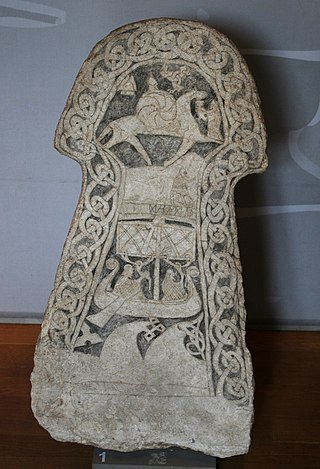
In Norse mythology, a valkyrie is one of a host of female figures who guide souls of the dead to the god Odin's hall Valhalla. There, the deceased warriors become einherjar. When the einherjar are not preparing for the cataclysmic events of Ragnarök, the valkyries bear them mead. Valkyries also appear as lovers of heroes and other mortals, where they are sometimes described as the daughters of royalty, sometimes accompanied by ravens and sometimes connected to swans or horses.

In Norse mythology, the einherjar are those who have died in battle and are brought to Valhalla by valkyries. In Valhalla, the einherjar eat their fill of the nightly resurrecting beast Sæhrímnir, and valkyries bring them mead from the udder of the goat Heiðrún. The einherjar prepare daily for the events of Ragnarök, when they will advance for an immense battle at the field of Vígríðr.
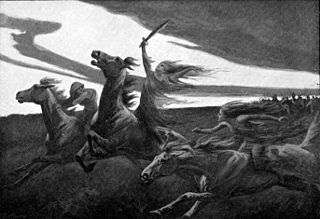
In Norse mythology, a dís is a female deity, ghost, or spirit associated with Fate who can be either benevolent or antagonistic toward mortals. Dísir may act as protective spirits of Norse clans. It is possible that their original function was that of fertility goddesses who were the object of both private and official worship called dísablót, and their veneration may derive from the worship of the spirits of the dead. The dísir, like the valkyries, norns, and vættir, are always referred collectively in surviving references. The North Germanic dísir and West Germanic Idisi are believed by some scholars to be related due to linguistic and mythological similarities, but the direct evidence of Anglo-Saxon and Continental German mythology is limited. The dísir play roles in Norse texts that resemble those of fylgjur, valkyries, and norns, so that some have suggested that dísir is a broad term including the other beings.
In Norse mythology, Mist is a valkyrie. Mist appears in valkyrie list in the Poetic Edda poem Grímnismál and both of the Nafnaþulur valkyrie lists. No further information is provided about her. Rudolf Simek says that her name, Mist, is likely related to Old Norse mistr, meaning "cloud, mist," and that this "reminds us of the way in which valkyries can ride through the air and over water," such as in the Poetic Edda poems Helgakviða Hjörvarðssonar and Helgakviða Hundingsbana II.
In Norse mythology, Élivágar are rivers that existed in Ginnungagap at the beginning of the world. The Prose Edda relates:
The streams called Ice-waves, those which were so long come from the fountain-heads that the yeasty atter upon them had hardened like the slag that runs out of the fire,-these then became ice; and when the ice halted and ceased to run, then it froze over above. But the drizzling rain that rose from the venom congealed to rime, and the rime increased, frost over frost, each over the other, even into Ginnungagap, the Yawning Void. Gylfaginning 5.

Helgi Hundingsbane is a hero in Norse sagas. Helgi appears in Volsunga saga and in two lays in the Poetic Edda named Helgakviða Hundingsbana I and Helgakviða Hundingsbana II. The Poetic Edda relates that Helgi and his mistress Sigrún were Helgi Hjörvarðsson and Sváva of the Helgakviða Hjörvarðssonar reborn. They were once again reborn as Helgi Haddingjaskati and Kára whose story survives as a part of the Hrómundar saga Gripssonar.

"Völsungakviða" or "Helgakviða Hundingsbana I" is an Old Norse poem found in the Poetic Edda. It is only preserved in the Icelandic manuscript Codex Regius. It constitutes one of the Helgi lays, together with Helgakviða Hundingsbana II and Helgakviða Hjörvarðssonar.

"Völsungakviða in forna" or "Helgakviða Hundingsbana II" is an Old Norse poem found in the Poetic Edda. It constitutes one of the Helgi lays together with Helgakviða Hundingsbana I and Helgakviða Hjörvarðssonar.
Hrómundar saga Gripssonar or The Saga of Hromund Gripsson is a legendary saga from Iceland. The original version has been lost, but its content has been preserved in the rímur of Hrómundr Gripsson, known as Griplur, which were probably composed in the first half of the 14th century, but appeared in print in 1896 in Fernir forníslenzkar rímnaflokkar, edited by Finnur Jónsson. These rímur were the basis for the not very appreciated Hrómunds saga which is found in the 17th-century MS of the Arnamagnæan Manuscript Collection, AM 587b 4°, as well as thirty-eight known later manuscripts. The saga as we now have it contains a number of narrative discrepancies, which are probably the result of the scribe working from a partly illegible manuscript of the rímur.
In Tacitus' work Germania from the year 98, regnator omnium deus was a deity worshipped by the Semnones tribe in a sacred grove. Comparisons have been made between this reference and the poem Helgakviða Hundingsbana II, recorded in the 13th century from earlier traditional sources.

"Helgakviða Hjörvarðssonar" is a poem collected in the Poetic Edda, found in the Codex Regius manuscript where it follows Helgakviða Hundingsbana I and precedes Helgakviða Hundingsbana II. The portion of text which constitutes the poem is unnamed in the manuscript and may never have been intended to be viewed as a single poem, though scholars have assigned it a name for convenience. The text appears to be a patchwork of old poems, glued together with prose passages. The poem relates the story of Helgi Hjörvarðsson, loosely connected to the story of Helgi Hundingsbani.
In Norse mythology, Kára is a valkyrie, attested in the prose epilogue of the Poetic Edda poem Helgakviða Hundingsbana II.
Helgi Haddingjaskati was a legendary Norse hero of whom only fragmentary accounts survive.
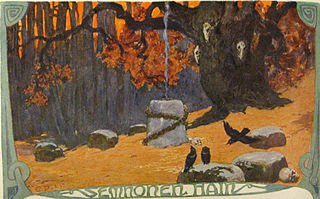
A grove of Fetters is mentioned in the Eddic poem "Helgakviða Hundingsbana II":

In Norse mythology, Sváfa or Sváva is a valkyrie and the daughter of king Eylimi. Consequently, she was probably the maternal aunt of Sigurd, the dragon slayer, although this is not explicitly mentioned in Helgakviða Hjörvarðssonar where Sváfa's story appears.
Surviving texts indicate that there was a belief in rebirth in Germanic paganism. Examples occur in eddic poetry and sagas, potentially associated with naming and/or through the family line. Scholars have discussed the implications of these attestations and proposed theories regarding belief in reincarnation among the Germanic peoples prior to Christianization and potentially to some extent in folk belief thereafter.

